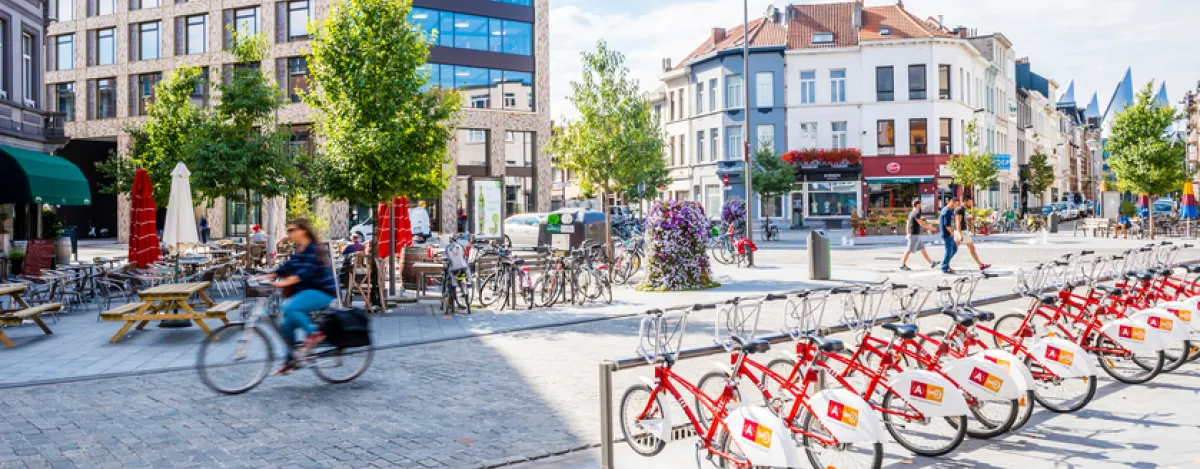Find more information here about travelling to Antwerp and getting around the city. We will also provide you with some practical information about your residence permit, opening a bank account in Belgium and why you might need a Belgium SIM card for your phone.
Getting to Antwerp
You can reach Antwerp easily by plane or train, even if it’s your first time in Belgium.
By plane
- Brussels Airport (Zaventem) is the main international airport and the easiest option. From here, you can reach Antwerp in about 45 minutes:
- Airport Express Bus direct to Antwerp city centre.
- Direct train from to Antwerp Central Station (via Brussels).
- Brussels South Charleroi Airport is mainly used by low-cost airlines (Ryanair, Wizz Air). With a direct shuttle bus, or a bus + train combination, you will reach Antwerp in 1.5 to 2 hours.
- Antwerp Airport (Deurne) is a small airport with limited international flights. By bus or tram, you reach the city centre in 15–25 minutes.
- Eindhoven Airport (NL) is also popular for low-cost flights. You can take a FlixBus to Antwerp (± 75 minutes) or bus + train via Eindhoven and Breda.
By train
- Antwerp has two main stations: Antwerp Central Station and Berchem station.
- Antwerp is well connected to the European high-speed rail network, including Thalys and Eurostar.
- International railway lines connect Antwerp to many major European cities:
- The Netherlands: Amsterdam, Rotterdam
- France: Paris, Lille
- Germany: Cologne, Düsseldorf
- United Kingdom: via Eurostar to Brussels, then a local train to Antwerp
Residence permit
A residence permit registers you as a legal resident in Belgium. It allows you to stay in the country for more than three months, access healthcare, open a bank account, and carry out official administrative tasks.
Who needs a residence permit?
Most students from outside Belgium who will live in the country for more than 3 months need a residence permit.
Exceptions:
- EEA+ nationals who only stay for one semester (exchange or internship): don’t have to apply for a residence permit. Obtaining a permit can take a considerable amount of time, and you may not receive it until you are almost ready to leave again. Please contact Student Services if you believe you still require a residence permit.
- NON-EEA students who study in another EU country with a valid EU residence permit and who come here for an exchange semester can register in Antwerp by sending an email to studentservices@kdg.be.
How to apply?
- You must have suitable accommodation in Antwerp before starting your application. Temporary stays in hostels or with friends do not qualify.
- Start your application as soon as possible. The process takes around 2 months, so you don’t want to wait too long after arriving.
- If you have accommodation in Antwerp or one of its districts (Antwerp, Berchem, Borgerhout, Deurne, Ekeren, Merksem, Hoboken, Wilrijk, Berendrecht-Zandvliet-Lillo), you have to apply through KdG. Do not go to the immigration office or Gate 15 without informing us; they will not let you in without an appointment.
- Start your application in Mobility Online. Enter your KdG username and password to log in. After filling in the online application sheet, you will receive an automated email to complete your application in Mobility Online.
- From that moment on, follow the different steps of your workflow in Mobility Online.
- If you have accommodation outside of Antwerp, you will need to contact your local municipality yourself to apply for a residence permit. Find below the list of documents you will need to bring.
Types of residence permits
- Students from neighbouring countries (France, the Netherlands, Luxembourg, Germany) can choose to either apply for a 'bijlage 33' or a full-fledged residence permit.
- A 'bijlage 33' keeps your main residence in your home country. You will not receive a national registry number.
- A residence permit registers your main residence in Belgium. You will receive a national registry number.
- EEA+ students (EU + Norway, Iceland, Liechtenstein, Monaco, Switzerland) will receive a national register number and an electronic residence card, which is valid for 5 years. One-semester exchange students do not need a permit (we recommend against it, as the process can take a considerable amount of time).
- NON-EEA students with visa type D (including UK) will receive a residence permit for one year and need to renew this every year
- NON-EEA students without visa type D: please contact studentservices@kdg.be
- NON-EEA students who are already in Belgium with a student residence permit (eg if you are transferring from another Flemish University) have to renew their residence permit at the latest one month before it expires! It is your own responsibility to check when and how you can apply for the extension. Please contact studentservices@kdg.be if you have any questions.
As a resident of the province of Antwerp, you are subject to an annual provincial tax of approximately 47 euros, and you will need to complete a tax declaration. This does not apply to students with an ‘annex 33’.
Documents you need
Students from neighbouring countries
- Completed information sheet (PDF): only needed if you don’t live in Antwerp and apply at your own municipality. Generated automatically via Mobility Online.
- ID or passport
- Form ‘formulier visum of verblijfstitel’ which you can download from e-studentservice
- Passport photo
- Residence document 'Bijlage 33' renewed yearly
EEA+ students
- Completed information sheet (PDF): only needed if you don’t live in Antwerp and apply at your own municipality.
- ID or passport
- Form ‘formulier visum of verblijfstitel’ which you can download from e-studentservice
- Health insurance: required (if you have a European Health Insurance Card, this is sufficient as proof of insurance).
- Declaration of sufficient resources: only needed if you don’t live in Antwerp (generated via Mobility Online).
- Residence document: valid for 5 years.
Non-EEA students
- Completed information sheet (PDF): only needed if you don’t live in Antwerp and apply at your own municipality.
- Passport (ID not accepted)
- Form ‘formulier visum of verblijfstitel’ which you can download from e-studentservice
- Health insurance
- Proof of solvency/sponsorship
- Residence document: residence card, renewed yearly.
Getting around Antwerp
And once you’re here, getting around the city is very simple whether it be on foot, by bike or by public transport.
Joining us in September?
You can find a tourist center in the Antwerp central station. There you can get information about Antwerp in general and learn all about your transport options for getting around the city including ticket info about De Lijn for buses and trams. Plus, you’ll get your very own plan of Antwerp.
You can also do your research right here. Read on for more info!
On foot
- Antwerp is especially good for walking. It is not too big and there’s so much to take in, so just follow Google maps to get from A to B and off you go!
- To give you an idea of distance, to get from Antwerp Central Station to the river Scheldt, via the main shopping street 'Meir', the 'Groenplaats' and the Town Hall only takes about 20 minutes.
- There are 3 ways to get from one side of the river to the other in Antwerp: 2 tunnels both accessible by bike or on foot, and the ferry, which can be a nice alternative if you’re exploring the city.
By bike
- Buying your own second-hand bike in Antwerp is a worthwhile investment. Wielredders and 2dehands are two sites to check out. There are also a few second-hand bike stores in Antwerp.
- Velo: You will notice the small red-and-white Velo bicycles as soon as you arrive in Antwerp. They have stations all over the city and it’s a really easy to use system. Want to fit in like a real local? A pass for a week is 12 euros, for a full year you’ll pay 58 euros.
- Swapfiets: Get a Swapfiets bicycle for a fixed price per month. Swapfiets ensures a bicycle that always works.
- Blue-bike: With Blue-bike you can easily get from the train station to your final destination and back. You can rent a bike in every big train station for as long as you need it. You pay 12 euros per year for your membership card and pay 3,5 euros for every first 24 hours.
Shared scooters
Bird, Lime, and Poppy provide shared scooters in Antwerp through a free-floating system: they have no fixed parking space, but you can locate them with an app. Use your smartphone to unlock the scooter and depart immediately. At the end of your journey, you must leave the scooter behind in a drop-off zone or in a place where it will not inconvenience anyone.
Scooters can only be ridden on bicycle lanes and you should wear a helmet.
By public transport
- De Lijn (buses and trams)
- Tram rides above and underground
- Trams are ideal to get around between the neighbourhoods of Antwerp. The moment you want to travel outside those, then the bus is your best option.
- Antwerp city card travel as much as you want, without the hassle of getting tickets. With this card, all transportation with trams and buses is included
- NMBS (train)
More useful links
- Slim naar Antwerpen (Smart ways to Antwerp) will give you all the different options to get from point A to point B with updated maps, and warns you when and where it will be crowded due to traffic or events.
- Visit Antwerp is the website of the tourist office in Antwerp. They can provide you with loads of information and advice on transportation.
- De Waterbus is a fast and cheap boat on the river Scheldt for if you want to explore more.
- Airport Express is a fast and cheap bus to get to and back from Brussels Airport Zaventem.
- Flixbus offers cheap bus rides all through Europe.
- b-Europe is the platform for international trains that pass through Belgium.

Opening a bank account
If you are a non-EEA student you are advised to open a Belgian account to reduce your international transaction costs. For EEA students this is not necessary but you may choose to do so.
If you would like to open a bank account in Belgium, a popular choice is BNP Paribas Fortis. Some other options for you are:
For more specific questions around banking contact studentservices@kdg.be
What kind of SIM card should you get?
If you are joining us from outside the EEA, you are advised to get a Belgian SIM card. EEA students can continue using an existing European SIM. Roaming charges may apply.
To get a Belgian SIM, choose between a prepaid account (short-term) or a subscription(long-term). You will need a Belgian bank account for a full subscription.
The most popular providers are:
More info about:
Pre-arrival essentials
Your arrival in Antwerp
Your first weeks at KdG
 Karel de Grote Hogeschool
Karel de Grote Hogeschool
